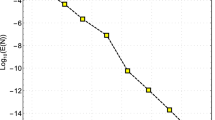Abstract
We consider a second-order differential equation that contains a fractional derivative (the Bagley–Torvik equation); here, the order of the derivative is in the range from 1 to 2 and is not known in advance. This model is used for describing oscillation processes in a viscoelastic medium. In order to study the equation, we use the Laplace transform; this makes it possible to obtain (in the explicit form) the image of the solution of the corresponding Cauchy problem. Numerical solutions for the various values of the parameter are constructed. Based on this solution, we propose a numerical technique for the parametric identification of an unknown order of the fractional derivative from the available experimental data. In the range of possible values of the parameter, the deviation function is determined by the least-squares method. The minimum of this function determines the search value of the parameter. The developed technique is tested on the experimental data for samples of polymer concrete, the fractional-derivative parameter in the model is determined, the theoretical and experimental curves are compared, and the accuracy of the parametric identification and the adequacy of the technique are established.





Similar content being viewed by others
REFERENCES
A. A. Chirkii and I. I. Matichin, “On linear conflict-controlled processes with fractional derivatives,” Tr. Inst. Mat. Mekh. UrO RAN 17, 256–270 (2011).
D. Ingman and J. Suzdalnitsky, “Control of damping oscillations by fractional differential operator with time-dependent order,” Comput. Methods Appl. Mech. Eng. 193, 5585–5595 (2004).
D. Ingman and J. Suzdalnitsky, “Iteration method for equation of viscoelastic motion with fractional differential operator of damping,” Comput. Methods Appl. Mech. Eng. 190, 5027–5036 (2001).
G. K. Koh and J. Kelly, “Application of fractional derivatives to seismic analysis of base-isolated models,” Earthquake Eng. Struct. Dyn. 19, 229–241 (1990).
Gh. E. Draganescu, N. Cofan, and D. L. Rujan, “Nonlinear vibrations of a nano-sized sensor with fractional damping,” J. Optoelectron. Adv. Mater. 7, 877–884 (2005).
A. Fenlander, “Modal synthesis when modeling damping by use of fractional derivatives,” AIAA J. 34, 1051–1058 (1996).
R. P. Meilanov and M. S. Yanpolov, “Features of the phase trajectory of a fractal oscillator,” Tech. Phys. Lett. 28, 30 (2002).
S. G. Samko, A. A. Kilbas, and O. I. Marichev, Integrals and Derivatives of Fractional Order and Some of their Applications (Nauka Tekhnika, Minsk, 1987) [in Russian].
R. L. Bagley and P. J. Torvik, “A thoretical basis for the application of fractional calculus to viscoelasticity,” J. Rheolog. 27, 201–203 (1983).
R. L. Bagley and P. J. Torvik, “Fractional calculus – a different approach to the analysis of viscoelastically damped structures,” J. AIAA 21, 741–748 (1983).
B. Ibrahim, Q. Dong, and Z. Fan, “Existence for boundary value problems of two-term Caputo fractional differential equations,” J. Nonlin. Sci. Appl., 511–520 (2017).
E. R. Kekharsaeva and V. G. Pirozhkov, “Modeling changes in the deformation-strength characteristics of asphalt concrete under loading using fractional calculus,” in Proceedings of the I. F. Obraztsov and Yu. G. Yanovskii 6th All-Russia Conference with International Participation on Mechanics of Composite Materials and Structures, Complex and Heterogeneous Media (IPRIM RAN, Moscow, 2016), pp. 104–109.
C. M. A. Vasques, R. A. S. Moreira, and J. Dias Rodrigues, “Experimental identification of GHM and ADF parameters for viscoelastic damping modeling,” in Proceedings of the 3rd European Conference on Computational Mechanics Solids, Structures and Coupled Problems in Engineering, Lisbon, Portugal, 2006, Ed. by C. A. Mota Soares et al.
V. A. Ditkin and A. P. Prudnikov, Integral Transforms and Operational Calculus (Nauka, Moscow, 1974; Pergamon, Oxford, 1965).
S. V. Erokhin, T. S. Aleroev, and L. Yu. Frishter, “Sturm-Liouville problem for the equationviscoelastic damping oscillator,” Int. J. Comput. Civil Struct. Eng. 11, 77–81 (2015).
E. R. Kekharsaeva and T. S. Aleroev, “Model of deformation-strength characteristics of chlorine-containing polyesters based on fractional derivatives,” Plast. Massy, No. 3, 35 (2001).
V. A. Man’kovskii and V. T. Sapunov, “Nomographic properties of fractional exponential E-functions when describing linear viscoelasticity,” Zavod. Lab. Diagn. Mater. 66 (3), 45–50 (2000).
Author information
Authors and Affiliations
Corresponding author
Additional information
Translated by L. Kartvelishvili
Rights and permissions
About this article
Cite this article
Aleroev, T.S., Erokhin, S.V. Parametric Identification of the Fractional-Derivative Order in the Bagley–Torvik Model. Math Models Comput Simul 11, 219–225 (2019). https://doi.org/10.1134/S2070048219020030
Received:
Published:
Issue Date:
DOI: https://doi.org/10.1134/S2070048219020030




